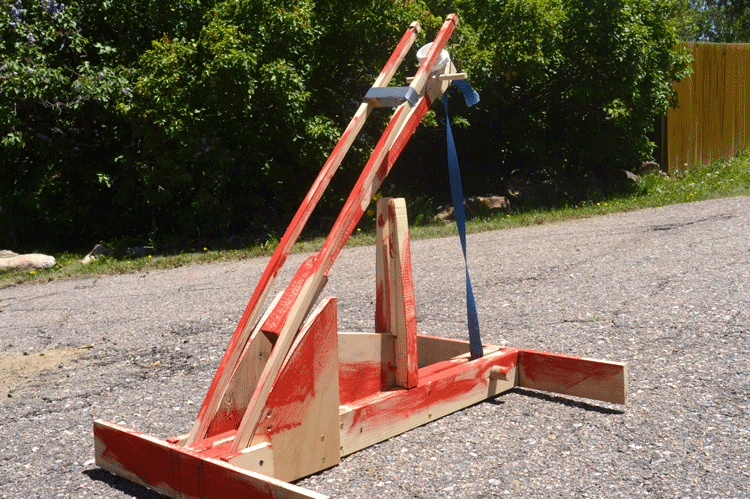
After competition, all catapults are painted red to ensure they are not used again by future students. photo by Maggie Fairfield
Physics students at TJ test their knowledge in the subject by building catapults to throw certain distances.
On Tuesday, April 26th, all physics students launched their catapults with the goal of hitting a can at three different distances. Physics teacher Nelson Vore has been doing this project for many years, and it has been a project that students look forward to throughout the year. Students are given three weeks in order to design, build, and test a wooden catapult made from scratch. By giving students a fun project that gives them the opportunity to learn exactly how motion works, students are able to apply their knowledge of physics in a creative way.
Building a catapult is not as easy as it sounds. While building the entire project, students have to meet certain requirements to be eligible for a good grade. “The base has to fit into a one-by-one meter square and has to be able to get into the classroom door in under a minute,” explained sophomore physics student, Andrew Seidenstat. In other words, catapults cannot be so big that they struggle to fit through the doorway. While building the catapults, students also have an option of what kind to build. There are trebuchets, mangonels, onagers, and ballistas, each type having its own way of operating and launching an object. The projectile it launches must range in size from a golf ball to a softball. Students must follow all of these rules or they are not allowed to launch. “Good design, followed by good construction, followed by quite a bit of practice gives you a winning catapult,” Vore explained.
On launch day, students stepped up to the line and launched their ball five meters, ten-and a-half meters, and a random distance in between picked by Vore, which ended up being eight meters. The ultimate goal is to knock the can over that is placed at the various distances, which gives a score of negative 200. Every time students launch their objects, Vore measures the distance from the can that the catapult is; the smaller the numbers the better. If the distance exceeds 200 meters, it is “not within range” and the student is given an automatic A and an added 200 points. The first place winners were sophomores Thomas Wilhelm and Aiden Maloof. The top fifteen catapults receive extra credit, so students were rewarded for building catapults that performed above and beyond. On top of that, five catapults received the Vore Award, which recognizes certain catapults for originality and creativity in their designs. Vore Awards also give students extra credit.
Vore strives to create projects that students can apply to their lives. “I don’t think there’s many places in school where you have to design a working mechanism from scratch and make it work, so I think the whole process is useful,” said Vore. Though most students will not be building another catapult, they can use the knowledge they learned for the rest of their lives. “This taught me how to adapt to a problem I may encounter and use problem solving skills,” said Seidenstat. Students had to use trial-and-error and learn from their mistakes in order to make the best catapult possible.
The skills students learn from this project are very important and will be able to help them approach other problems for the rest of their lives. By using a fun way to teach important physics theories, the catapult project is a great project that will be assigned in many years to come.